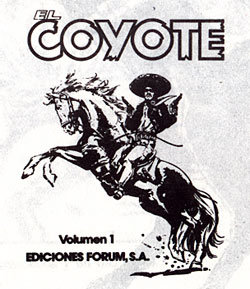

The name Joaquín has a long standing history in the California region. In Juan Bautista De Anza's expedition to California there was a family with a patriarch by the name of José Joaquín Moraga, whose son Gabriel gave the name of San Joaquín to one of the rivers of the state. From this name came the San Joaquín County, the town San Joaquín,and the San Joaquín Valley.
As accounts of alleged Mexican bandits began to be published in newspapers, journalists hadn't any solid information as to who these perpetrators were, except that one of them might be named Joaquín. The first time the name Joaquín Murrieta appeared in a San Francisco newspaper Alta California on December 15, 1852. A newspaper named San Joaquín Republican, of Stockton, published another such notice:
It is well known that during the winter months a band of
Mexican marauders have infested Calaveras county, and
weekly we receive the details of dreadful murders and out-
rages committed in the lonely gulches and solitary outposts
of that region. The farmers lost their cattle and horses, the
trader's tent was pillaged, and the life of every traveler was
insecure [....] The band is lead [sic] by a robber, named
Joaquín, a very desperate man, who was concerned in the murder
of four Americans, sometime ago, at Turnerville.(latta 1980:37)
Joaquín was soon attributed with all assaults, robberies, and murders that occured shortly thereafter and he quickly became a figure of mythical proportions, who could commit crimes in many locations over several miles on the same day. It soon became evident that they were dealing with more than one Joaquín, but they were all identified with the name of one, Joaquín Murrieta.
Facts
On May 11, 1853 Governor John Bigler signed a legislative act authorizing a band of California Rangers under the command of Capt. Harry Love to organize. Their primary objective was to capture and terminate a gang of robbers and cattle rustlers commanded by the "Five Joaquíns". They were Joaquín Botellier, Joaquín Carrillo, Joaquín Murrieta, Joaquín Ocomorenia, and Joaquín Valenzuela and were believed to be responsible for the majority of all rustling, robberies and murders committed in the Mother Lode region since 1850.
Love and his Rangers came across a group of Mexican men in San Benito County in July of 1853. A shootout ensued resulting in the deaths of two of the men. Love had the hand of one man and the head of the other cut off and placed in jars of alcohol. Later he claimed that they belonged to "Three-fingered Jack" and Joaquín Murrieta respectively.
Despite not being able to prove that the head and hand belonged to the notorious outlaws and despite only having supposedly killed one of the Joaquíns, Love was awarded the bounty of $1000 by Governor Bigler. Later, another sum of $5000 was approved by the legislature and awarded to Love.
Perpetuation of a Legend
John "Yellow Bird" Rollin Ridge
Perhaps no one had done more to perpetuate the legend of Joaquín Murrieta than San Francisco journalist John Rollin Ridge, who in 1854, published a highly sensational and fictional account of Joaquín's life titled, The Life & Adventures of Joaquín Murieta. This book has been lost and plagiarized several times over by writers from all over the world. However, Ridge 's book is credited as the original published story of Murrieta's life.
In the book Ridge writes about a young handsome miner, whose wife is murdered by Anglos and whose brother is hanged for a crime he didn't commit. Murieta then swears vengeance on all Anglos, and together with a band of cutthroats punishes them by robbing, pillaging, and sometimes murdering them.
The dramatic display of the supposed head of Murrieta is another event that truly marks the point, in which, the character Joaquín Murieta achieves Legendary status. Many "Dime Novels" were later written about Joaquín and his exploits and adventures. The most recognized manifestation of the Murrieta figure has to be that of Walt Disney's Zorro.
During the McCarthy witchhunts of the post-World War II era, Disney, himself, was involved in naming cartoonists in his own employ as communists. It is in this context that the story of Zorro was born. The creation, of Johnston McCully, was inspired by a previous characterization of Murrieta called "El Coyote" (created by José Mallorqui Figuerola). El Coyote was a Spanish version of the Murrieta figure, who also fought for justice against Anglos. Although Zorro shares his Spanish heritage with El Coyote, the similarities end there. Unlike El Coyote and Murrieta, El Zorro battles injustices of Spanish government in a pre-independence from Mexico era. Perhaps, this characteristic of fighting the system was in response to the McCarthy hearings of the time.